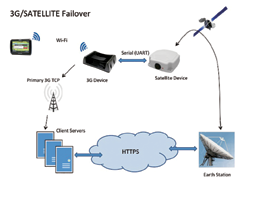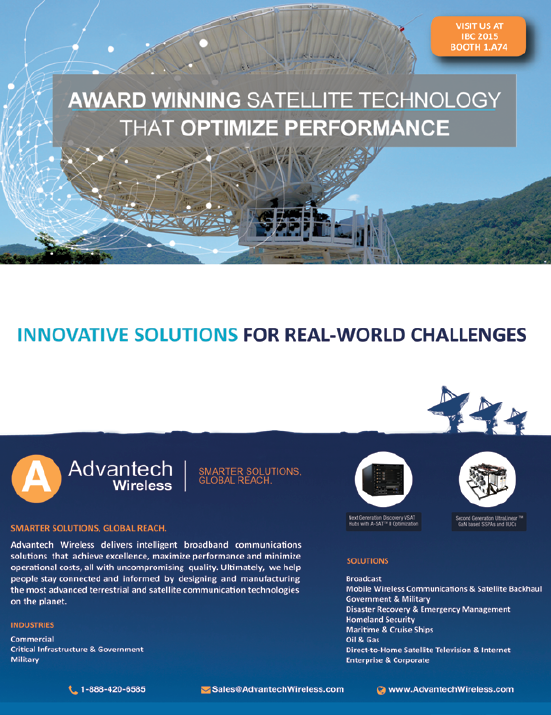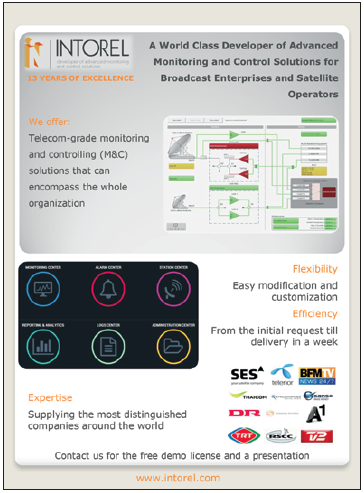Real-time connectivity is becoming increasingly critical to the functioning of certain applications, and more specifically, mobile applications.

Whether a mobile asset travels outside of cellular reception, or during natural disasters, a secondary communication route completely independent of the terrestrial infrastructure is required to ensure that the data traffic flows back to the main servers.
A number of dual-mode communication terminals that deliver connectivity to assets transitioning in and out of cellular range already exist in today’s market. These terminals are used for emergency services, where constant connectivity and visibility of the asset are essential, such as with transport vehicles or maritime vessels. Any downtime means the loss of connectivity as well as a risk to people’s lives.
In a sparsely inhabited country such Australia, only populated areas have cellular coverage—these areas form only 10 percent of the total land space. Therefore, at least one secondary communication system is required in a large majority of the country where cellular coverage is weak or completely absent.
The same concept applies to the sea, where vessels operating in close proximity to the shore are usually within the range of cellular coverage. However, as these vessels sail deeper into the sea, the coverage is lost. Land or sea, mobile assets require some form of connection to transmit data back to a data center. This data may be in the form of a simple position report that contains the coordinates of latitude and longitude, job acknowledgments or even duress information.
Simultaneously, the data center might need to send information to the asset in the field, such as data for job dispatching, hazard notifications and rerouting. When transporting dangerous or hazardous material, real-time monitoring is necessary so that tracking is maintained at all times.
The same applies when crossing the borders of different countries, as the asset can still be connected to multiple terrestrial networks—this requires more than national roaming capabilities and becomes global roaming. However, the current definition of global roaming does not take into consideration the areas where mobile connectivity is absent, which remains a major limitation. In such areas, the
satellite network can be used to fill the gaps between different cellular networks and achieve what can be classified as “real global roaming.”
However, using the failover mechanism could have its own risks.
Least-cost routing is a simple but complicated practice that identifies the most cost-effective pathway to route data traffic. In the absence of terrestrial connectivity, the selection of the correct conditions to switch between networks is absolutely crucial. This allows all, or part, of the traffic to be selectively forwarded onto the satellite path, which can be an expensive method of communication if such is not well monitored. With satellite connectivity, application prioritization is vital to apply to traffic control to ensure only critical data is sent over satellite to avoid shocking bills. Such bills can also be avoided with a reliable reversion to cellular when it becomes available again.
At M2M Connectivity, the company has found that, for specific applications, several variants have to be taken into consideration to deliver an efficient and reliable least-cost routing mechanism—engineers have developed several algorithms to customize the failover system to suit the specific needs of the application as requested by the client. In these cases, thorough monitoring is applied to the data transmitted through the more expensive route, in this instance, the satellite. In addition, this allows the correct decisions to be made as to when to optimally switch between different available networks.
In a number of applications, more than two networks may be required (i.e., radio communications). This further complicates the application, an off-the-shelf solution would be difficult to find. In such cases, M2M Connectivity’s customization becomes a “must,” due to the many advantages offered. These include the ability to choose the precise technology, the appropriate networks, the proper hardware and the intelligence to drive the application.

All are heading toward a constantly connected world where information should be accessible at any time and at any location without data delay or loss. This is why the failover application is of immense importance. Due to the advantages of combining different technologies and networks, the asset is able to remain connected—everywhere and at all times.
Roland is a Sales Engineer at M2M Connectivity who specializes in satellite technology and products. He provides developers and customers with technical support and application development. Roland has extensive knowledge of many satellite products, one-way and duplex data transmission through to IP connectivity for remote M2M solutions. As a specialist satellite engineer, Roland’s knowledge and experience of the Inmarsat, Iridium and Globalstar Simplex networks extends to the products designed for these networks and how they are best utilized to achieve the desired outcomes in M2M applications.



